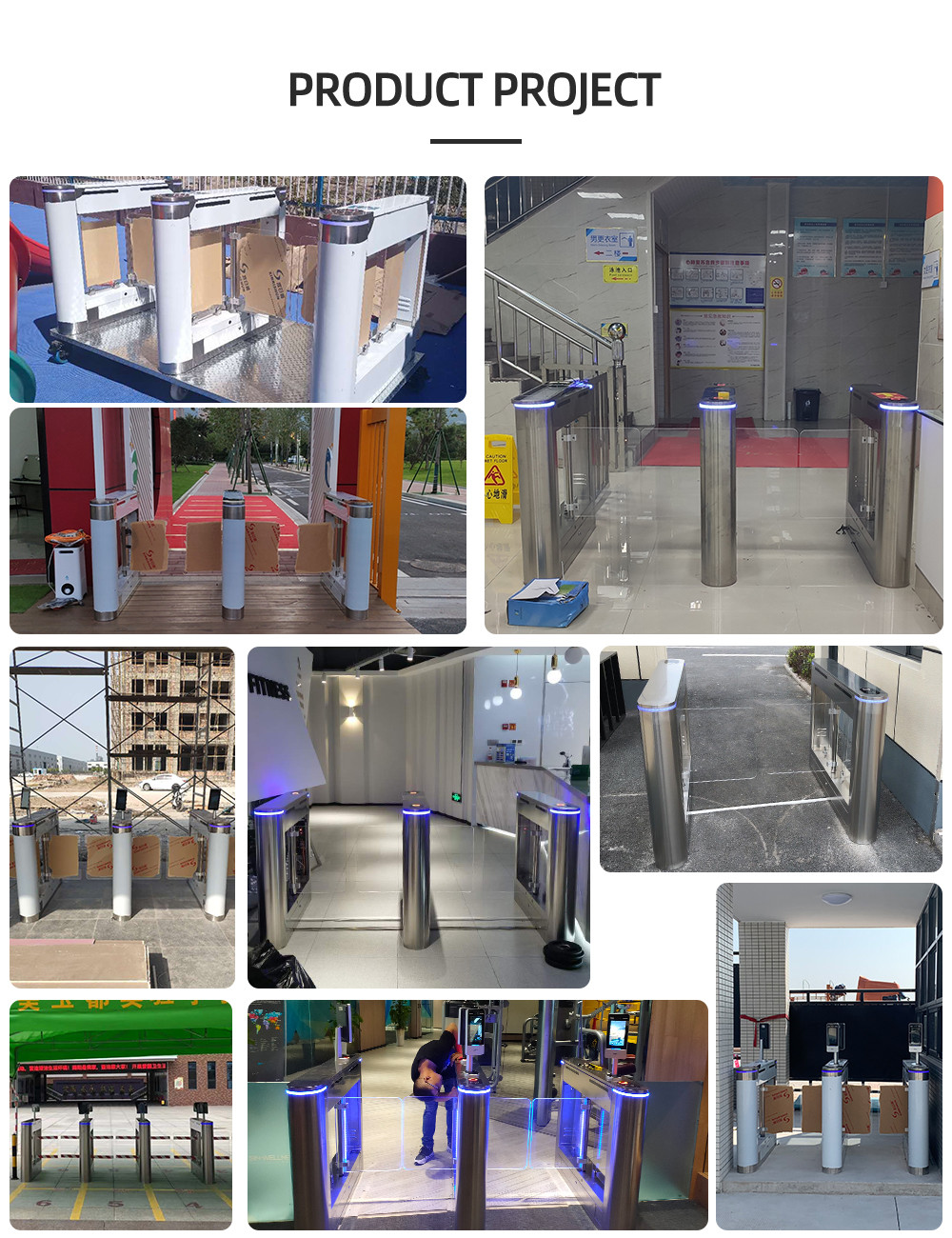Advanced And Intelligent Long Lifespan Bio Metric Speed Gate Swing
Turnstile For Pedestrian Passing
Product Features
- Full modernized design, fast pass speed.
- Slim machine structure, save the installation space.
- By using 6 pairs of military level high-performance infrared
sensors and exact algorithms, it can accurately detect the
pedestrian’s passing position to achieve the purposes such as
anti-tailgating, anti-reverse passing and anti-clamping etc.
- Use the multiple anti-clamping designs to protect the personal
safety of passengers in maximum limit.
- The widen lane is optional for carrying luggage and wheelchair
access.
- Equipped with the dry contact signal input interface, RS485
interface, TCP/IP interface(optional), compatible with all kinds of
access controllers.
Advanced & Intelligent Turnstile Core Technology
Swing gate turnstile passing detection kernel algorithm and matrix
type photoelectric stereoscopic detection technology , it can
sensitively detect the behaviors that threaten the passageway
safety, such as reversed passing, tail-gating, illegal intrusion
and send out audible and visual alarms. The turnstile can be also
linked with other security systems.
Strong & Stable Turnstile Control Core
Long Lifespan: independent research & development of lossless mechanism
structure and high-quality imported DC brushless motor (mechanism
core) are configured to ensure turnstile long lifespan. Turnstile's mechanism & control system has passed 10 million
lifetime test.
Advanced motor control technology: Adopting advanced servo control system and DSP+ARM motor control
technology, combining original motor control algorithm, it can
truly complete precise control & positioning & stable performance.
SPECIFICATIONS:
| Framework | 304# Stainless Steel (default), 201# or 316# Stainless Steel or
paint (optional) |
| Thickness of ply | 1.5mm |
| Finish | brushed surface, polishing surface |
| Shell's size (L*W*H) | 1300*150*990mm |
| Swing arm material | Tempered glass or Acrylic (optional) |
| Stretching out swing length | 260mm~600mm |
| The inductive card reader dimension | equipped with the standard mounting brackets or tailor. |
| Machine center | Germany technological motor |
| Power voltage | AC220V±10%, 50Hz±10% |
| Driver motor | DC36 servo motor |
| Main-board voltage | 12V DC |
| In-built Infrared | 4 pairs/passageway |
| Passing speed in normally open mode | 50 persons/min |
| Passing speed in normally closed mode | 40 persons/min |
| Passage Width | 600mm |
| Swing arm transmission angle | 180° |
| Swinging direction | unidirectional or bi-directional |
| Opening / closing time | 1 seconds |
| The time required to running state after power on | 3 seconds |
| Automatic reset time after the failure | 1 seconds |
| Mean time to failure | min. 10 000 000 |
| Operation temperature | -10℃ ~ +70℃ |
| Relative humidity | less than 95% not condensed |
| Working Environment | Indoor/Outdoor (with rain-tent cover) |
| Input port | relay dry contact signal; +12V level signal, pulse width >100ms,
DC12V pulse signal |
| Communications port | RS232/ RS485 electric standard, communications range ≤1200m.
Available to connect with external CAN BUS and Ethernet |
Working types
In the swing gate products, there are three working types for users
to choose at the entrance and exit: controlled
passing, free passing and no passing. Namely there are nine working
types for users to choose for one lane in
open status and normal close status:
1) Controlled at both entrance and exit: it needs to read card to
pass through at both the entrance and exit;
2) Controlled at entrance, free at exit: it needs to read card at
entrance, and it does not need to read card at
exit to pass through;
3) Controlled at entrance, no passage at exit: it needs to read
card at entrance, and no one can pass through at
the exit;
4) Free at entrance, controlled at exit: it does not need to read
card at entrance to pass through, and it needs to
read card at exit to pass through;
5) Free at entrance, free at exit: it does not need to read card at
entrance and exit to pass through;
6) Free at entrance, no passage at exit: it does not need to read
card at entrance to pass though, and no one is
allowed to pass through at exit;
7) No passage at entrance, controlled at exit: no one is allowed to
pass through at entrance, and it needs to
read card at exit to pass through;
8) No passage at entrance, free at exit: no one is allowed to pass
through at entrance, and it does not need to
read card at exit to pass through;
9) No passage at entrance, no passage at exit: passage is cut off,
and on one is allowed to pass through at both
entrance and exit;










